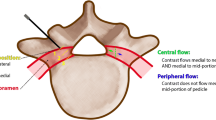Abstract
Purpose
To assess the performance of sterile saline solution as the sole contrast agent for percutaneous magnetic resonance imaging (MRI)-guided epidural injections at 1.5 T.
Methods
A retrospective analysis of two different techniques of MRI-guided epidural injections was performed with either gadolinium-enhanced saline solution or sterile saline solution for documentation of the epidural location of the needle tip. T1-weighted spoiled gradient echo (FLASH) images or T2-weighted single-shot turbo spin echo (HASTE) images visualized the test injectants. Methods were compared by technical success rate, image quality, table time, and rate of complications.
Results
105 MRI-guided epidural injections (12 of 105 with gadolinium-enhanced saline solution and 93 of 105 with sterile saline solution) were performed successfully and without complications. Visualization of sterile saline solution and gadolinium-enhanced saline solution was sufficient, good, or excellent in all 105 interventions. For either test injectant, quantitative image analysis demonstrated comparable high contrast-to-noise ratios of test injectants to adjacent body substances with reliable statistical significance levels (p < 0.001). The mean table time was 22 ± 9 min in the gadolinium-enhanced saline solution group and 22 ± 8 min in the saline solution group (p = 0.75).
Conclusion
Sterile saline is suitable as the sole contrast agent for successful and safe percutaneous MRI-guided epidural drug delivery at 1.5 T.




Similar content being viewed by others
References
Riew KD, Yin Y, Gilula L et al (2000) The effect of nerve-root injections on the need for operative treatment of lumbar radicular pain. A prospective, randomized, controlled, double-blind study. J Bone Joint Surg Am 82:1589–1593
Groenemeyer DHW, Seibel RMM (1990) Interventional computed tomography. Blackwell, Oxford
Richards RJ, George J, Metelko M et al (2010) Spine computed tomography doses and cancer induction. Spine 35:1–4
Groenemeyer D, Seibel RM, Kaufmann L (1990) Interventional procedures in low field magnetic resonance imaging. Diagn Imaging 11:32–36
Lufkin R, Teresi L, Hanafee W (1987) New needle for MR-guided aspiration cytology of the head and neck. AJR Am J Roentgenol 149:380–382
Mueller PR, Stark DD, Simeone JF et al (1986) MR-guided aspiration biopsy: needle design and clinical trials. Radiology 161:605–609
Busch M, Bornstedt A, Wendt M et al (1998) Fast “real time” imaging with different k-space update strategies for interventional procedures. J Magn Reson Imaging 8:944–954
Yutzy SR, Duerk JL (2008) Pulse sequences and system interfaces for interventional and real-time MRI. J Magn Reson Imaging 27:267–275
Smith KA, Carrino J (2008) MRI-guided interventions of the musculoskeletal system. J Magn Reson Imaging 27:339–346
Lewin JS, Duerk JL, Jain VR et al (1996) Needle localization in MR-guided biopsy and aspiration: effects of field strength, sequence design, and magnetic field orientation. AJR Am J Roentgenol 166:1337–1345
Jerosch J, Groenemeyer D, Deli M et al (2000) Precision and comparison of CT-, MRI- and DL-controlled interventions exemplified by lumbar facet infiltration—an experimental study. Biomed Tech 45:228–237
Fritz J, Thomas C, Clasen S et al (2009) Freehand real-time MRI-guided lumbar spinal injection procedures at 1.5 T: feasibility, accuracy, and safety. AJR Am J Roentgenol 192:W161–W167
Fritz J, Tzaribachev N, Thomas C et al (2011) Evaluation of MR imaging guided steroid injection of the sacroiliac joints for the treatment of children with refractory enthesitis-related arthritis. Eur Radiol 21:1050–1057
Fritz J, Clasen S, Boss A et al (2008) Real-time MR fluoroscopy-navigated lumbar facet joint injections: feasibility and technical properties. Eur Radiol 18:1513–1518
Fritz J, Thomas C, Tzaribachev N et al (2009) MRI-guided injection procedures of the temporomandibular joints in children and adults: technique, accuracy, and safety. AJR Am J Roentgenol 193:1148–1154
Salonen OL (1990) Case of anaphylaxis and four cases of allergic reaction following Gd-DTPA administration. J Comput Assist Tomogr 14:912–913
Graves MJ, Wakely S, Bearcroft PW et al (2008) MR-guided direct arthrography of the hip. J Magn Reson Imaging 28:462–465
Petersilge CA, Lewin JS, Duerk JL et al (1997) MR arthrography of the shoulder: rethinking traditional imaging procedures to meet the technical requirements of MR imaging guidance. AJR Am J Roentgenol 169:1453–1457
Streitparth F, Walter T, Wonneberger U et al (2010) Image-guided spinal injection procedures in open high-field MRI with vertical field orientation: feasibility and technical features. Eur Radiol 20:395–403
Fritz J, Henes JC, Thomas C et al (2008) Diagnostic and interventional MRI of the sacroiliac joints using a 1.5-T open-bore magnet: a one-stop-shopping approach. AJR Am J Roentgenol 191:1717–1724
Acknowledgments
We thank Silke Lange for her support in the statistical data analysis and Aliki Papathanassiou for her support as a second rater in the interrater reliability test of the qualitative assessment.
Conflict of interest
The authors declare that they have no conflict of interest.
Author information
Authors and Affiliations
Corresponding author
Additional information
The work was performed at the Groenemeyer Institute for Microtherapy (GIMT), Universitaetsstrasse 142, 44799 Bochum, Germany.
Rights and permissions
About this article
Cite this article
Deli, M., Fritz, J., Mateiescu, S. et al. Saline as the Sole Contrast Agent for Successful MRI-guided Epidural Injections. Cardiovasc Intervent Radiol 36, 748–755 (2013). https://doi.org/10.1007/s00270-012-0489-7
Received:
Accepted:
Published:
Issue Date:
DOI: https://doi.org/10.1007/s00270-012-0489-7




